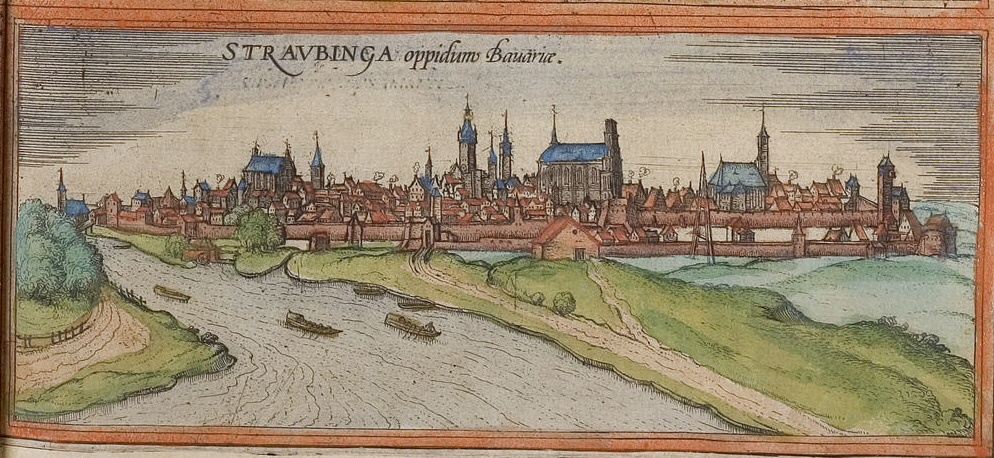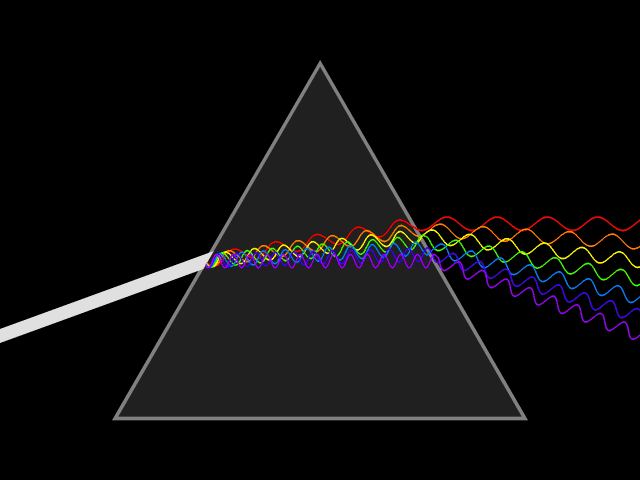|
Joseph Von Fraunhofer
Joseph Ritter von Fraunhofer (; ; 6 March 1787 – 7 June 1826) was a German physicist and optical lens manufacturer. He made optical glass, an achromatic telescope, and objective lenses. He developed diffraction grating and also invented the spectroscope. In 1814, he discovered and studied the dark absorption lines in the spectrum of the sun now known as Fraunhofer lines. The German research organization Fraunhofer Society, which is Europe's biggest Society for the advancement of applied research, is named after him. Fraunhofer lines are used in astronomy to determine the composition of celestial bodies. His epitaph reads , Latin for Biography Joseph Fraunhofer was the 11th child, born into a Roman Catholic family in Straubing, in the Electorate of Bavaria, to Franz Xaver Fraunhofer and Maria Anna Fröhlich. His father and paternal grandfather Johann Michael had been master glassmakers in Straubing. Fröhlich's family also came from a lineage of glassmakers going back to ... [...More Info...] [...Related Items...] OR: [Wikipedia] [Google] [Baidu] |
Straubing
Straubing (; Central Bavarian: ''Strauwing'') is an independent city in Lower Bavaria, southern Germany. It is seat of the Districts of Germany, district of Straubing-Bogen. Annually in August the Gäubodenvolksfest, the second largest fair in Bavaria, is held. The city is located on the Danube forming the centre of the Gäuboden. History The area of Straubing has been continuously settled since the Neolithic. The conquest by the Roman Empire, Romans in 16–14 BC had a dramatic impact on the whole region. Even today many traces of the 400-year Roman occupation can be found: for example, the famous 'Römerschatz' (Roman treasure) which was excavated in 1950 and which is shown in the Gäubodenmuseum. ''Sorviodurum'', as the Romans called it, was an important military support base. After the fall of the Roman Empire Straubing became a centre of settlement of the Bavarii, mostly around St. Peter's Church, Straubing, St. Peter's Church (built in the 9th century) between Allachbach ... [...More Info...] [...Related Items...] OR: [Wikipedia] [Google] [Baidu] |
Applied Research
Applied science is the application of the scientific method and scientific knowledge to attain practical goals. It includes a broad range of disciplines, such as engineering and medicine. Applied science is often contrasted with basic science, which is focused on advancing scientific theories and laws that explain and predict natural or other phenomena. There are applied natural sciences, as well as applied formal and social sciences. Applied science examples include genetic epidemiology which applies statistics and probability theory, and applied psychology, including criminology. Applied research Applied research is the use of empirical methods to collect data for practical purposes. It accesses and uses accumulated theories, knowledge, methods, and techniques for a specific state, business, or client-driven purpose. In contrast to engineering, applied research does not include analyses or optimization of business, economics, and costs. Applied research can be better unde ... [...More Info...] [...Related Items...] OR: [Wikipedia] [Google] [Baidu] |
Physics Today
''Physics Today'' is the membership magazine of the American Institute of Physics. First published in May 1948, it is issued on a monthly schedule, and is provided to the members of ten physics societies, including the American Physical Society. It is also available to non-members as a paid annual subscription. The magazine informs readers about important developments in overview articles written by experts, shorter review articles written internally by staff, and also discusses issues and events of importance to the science community in politics, education, and other fields. The magazine provides a historical resource of events associated with physics. For example it discussed debunking the physics of the Star Wars program of the 1980s, and the state of physics in China and the Soviet Union during the 1950s and 1970s. According to the ''Journal Citation Reports'', the journal has a 2017 impact factor The impact factor (IF) or journal impact factor (JIF) of an academic jou ... [...More Info...] [...Related Items...] OR: [Wikipedia] [Google] [Baidu] |
Michael Faraday
Michael Faraday (; 22 September 1791 – 25 August 1867) was an English chemist and physicist who contributed to the study of electrochemistry and electromagnetism. His main discoveries include the principles underlying electromagnetic induction, diamagnetism, and electrolysis. Although Faraday received little formal education, as a self-made man, he was one of the most influential scientists in history. It was by his research on the magnetic field around a Electrical conductor, conductor carrying a direct current that Faraday established the concept of the electromagnetic field in physics. Faraday also established that magnetism could Faraday effect, affect rays of light and that there was an underlying relationship between the two phenomena. the 1911 ''Encyclopædia Britannica''. He similarly discovered the principles of electromagnetic induction, diamagnetism, and the Faraday's laws of electrolysis, laws of electrolysis. His inventions of electric motor, electromagnetic rotar ... [...More Info...] [...Related Items...] OR: [Wikipedia] [Google] [Baidu] |
Pierre-Louis Guinand
Pierre-Louis Guinand (1748–1824) was a Swiss lens maker. who in the late 1700s came up with a breakthrough for making better quality and larger glass, and in time went on to teach a young Fraunhofer at Joseph von Utzschneider's (1763-1840) glassworks, and eventually started his own optical glass works. Guinand would supply glass for the Paris Observatory The Paris Observatory (, ), a research institution of the Paris Sciences et Lettres University, is the foremost astronomical observatory of France, and one of the largest astronomical centres in the world. Its historic building is on the Left Ban ... telescopes and also Cauchoix. He was a pioneer in the manufacture of optical glass for microscopes, telescopes, glasses and other optical instruments. See also * Markree Observatory#Pierre-Louis Guinand References Bibliography * 1748 births 1824 deaths Scientific instrument makers Lens designers People from the Principality of Neuchâtel {{Switz ... [...More Info...] [...Related Items...] OR: [Wikipedia] [Google] [Baidu] |
Dispersion (optics)
Dispersion is the phenomenon in which the phase velocity of a wave depends on its frequency. Sometimes the term chromatic dispersion is used to refer to optics specifically, as opposed to wave propagation in general. A medium having this common property may be termed a dispersive medium. Although the term is used in the field of optics to describe light and other electromagnetic waves, dispersion in the same sense can apply to any sort of wave motion such as acoustic dispersion in the case of sound and seismic waves, and in gravity waves (ocean waves). Within optics, dispersion is a property of telecommunication signals along transmission lines (such as microwaves in coaxial cable) or the Pulse (signal processing), pulses of light in optical fiber. In optics, one important and familiar consequence of dispersion is the change in the angle of refraction of different colors of light, as seen in the spectrum produced by a dispersive Prism (optics), prism and in chromatic aberration ... [...More Info...] [...Related Items...] OR: [Wikipedia] [Google] [Baidu] |
Benedictine
The Benedictines, officially the Order of Saint Benedict (, abbreviated as O.S.B. or OSB), are a mainly contemplative monastic order of the Catholic Church for men and for women who follow the Rule of Saint Benedict. Initiated in 529, they are the oldest of all the religious orders in the Latin Church. The male religious are also sometimes called the Black Monks, especially in English speaking countries, after the colour of their habits, although some, like the Olivetans, wear white. They were founded by Benedict of Nursia, a 6th-century Italian monk who laid the foundations of Benedictine monasticism through the formulation of his Rule. Benedict's sister, Scholastica, possibly his twin, also became a religious from an early age, but chose to live as a hermit. They retained a close relationship until her death. Despite being called an order, the Benedictines do not operate under a single hierarchy. They are instead organized as a collection of autonomous monasteries ... [...More Info...] [...Related Items...] OR: [Wikipedia] [Google] [Baidu] |
Benediktbeuern Abbey
Benediktbeuern Abbey (Kloster Benediktbeuern) is an institute of the Salesians of Don Bosco, originally a monastery of the Benedictine Order, in Benediktbeuern in Bavaria, near the Kochelsee, 64 km south-south-west of Munich. It is the oldest and one of the most beautiful monasteries in Upper Bavaria. It was badly damaged in an extreme weather event in 2023. First Benedictine foundation The monastery, dedicated to Saints James and Benedict, was founded in around 739/740 as a Benedictine abbey by members of the Huosi, a Bavarian noble clan, who also provided the three brothers who served one after the other as the first three abbots, traditionally named as Lanfrid, Waldram (or Wulfram), and Eliland, for nearly a century. It is possible that Saint Boniface had an involvement in the foundation; he may have consecrated the church (to the holy Trinity), though this is not widely accepted. There was here a school of writing, whose work survives in the form of numerous codices ... [...More Info...] [...Related Items...] OR: [Wikipedia] [Google] [Baidu] |
Georg Von Reichenbach
Georg Friedrich von Reichenbach (24 August 1771 – 21 May 1826) was a German scientific instrument maker. Early life Reichenbach's father was a master mechanic, and a master cannon-borer, who moved to Mannheim when Reichenbach was two, and became manager of the cannon-boring works there. At 14 Georg was admitted to the Military School at Mannheim where he got to know the astronomer at the Mannheim Observatory. He received a knowledge of mathematical instruments and was inspired to try to construct similar instruments in his father's workshop. The Director of the Observatory sent a sextant made by Reichenbach to Count Rumford. When he was 19, Reichenbach received a grant of 500 gulden for a journey to London, and introductions to the engineers James Watt and Matthew Boulton. Reichenbach's first visit to England lasted from 1 June 1791 to January 1792, when he returned home for a short time before returning to England. He made drawings of Watt's steam engine despite Watt's attempt ... [...More Info...] [...Related Items...] OR: [Wikipedia] [Google] [Baidu] |
Maximilian I Joseph Of Bavaria
Maximilian I Joseph (; 27 May 1756 – 13 October 1825) was Duke of Zweibrücken from 1795 to 1799, prince-elector of Bavaria (as Maximilian IV Joseph) from 1799 to 1806, then King of Bavaria (as Maximilian I Joseph) from 1806 to 1825. He was a member of the House of Palatinate-Birkenfeld-Zweibrücken, a branch of the House of Wittelsbach. Early life Maximilian, the son of the Count Palatine Frederick Michael of Zweibrücken-Birkenfeld and Maria Francisca of Sulzbach, was born on 27 May 1756 at Schwetzingen, between Heidelberg and Mannheim. After the death of his father of testicular cancer in 1767, he was left at first without parental supervision, since his mother had been banished from her husband's court after giving birth to a son fathered by an actor. Maximilian was carefully educated under the supervision of his uncle, Duke Christian IV of Zweibrücken, who settled him in the Hôtel des Deux-Ponts. He became Count of Rappoltstein in 1776 and took service in 1777 ... [...More Info...] [...Related Items...] OR: [Wikipedia] [Google] [Baidu] |





